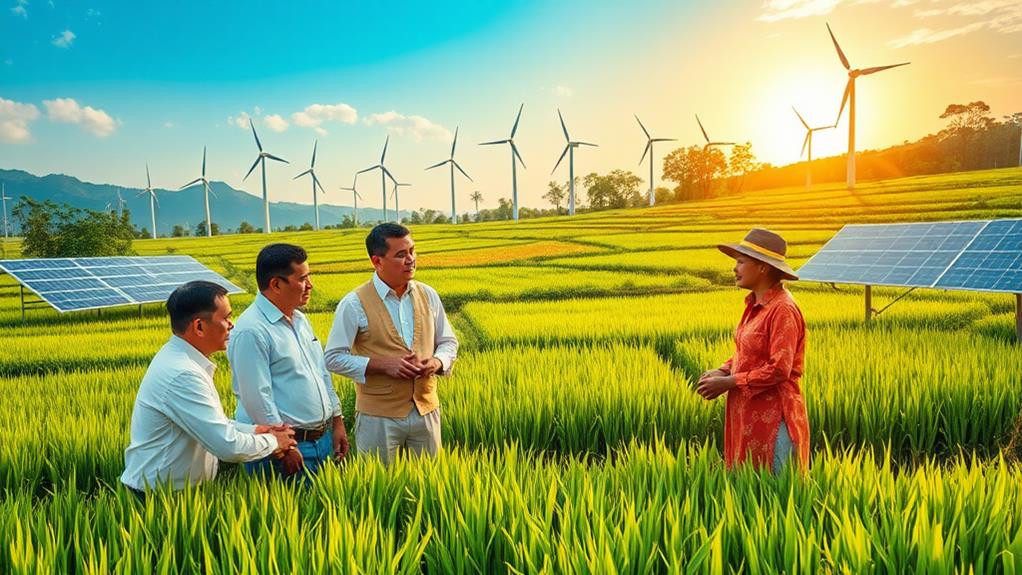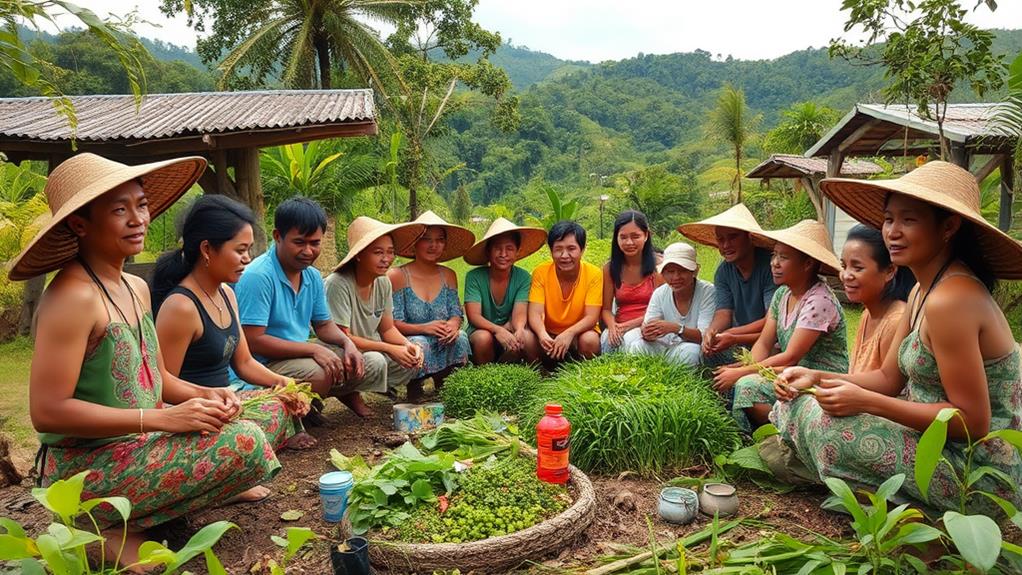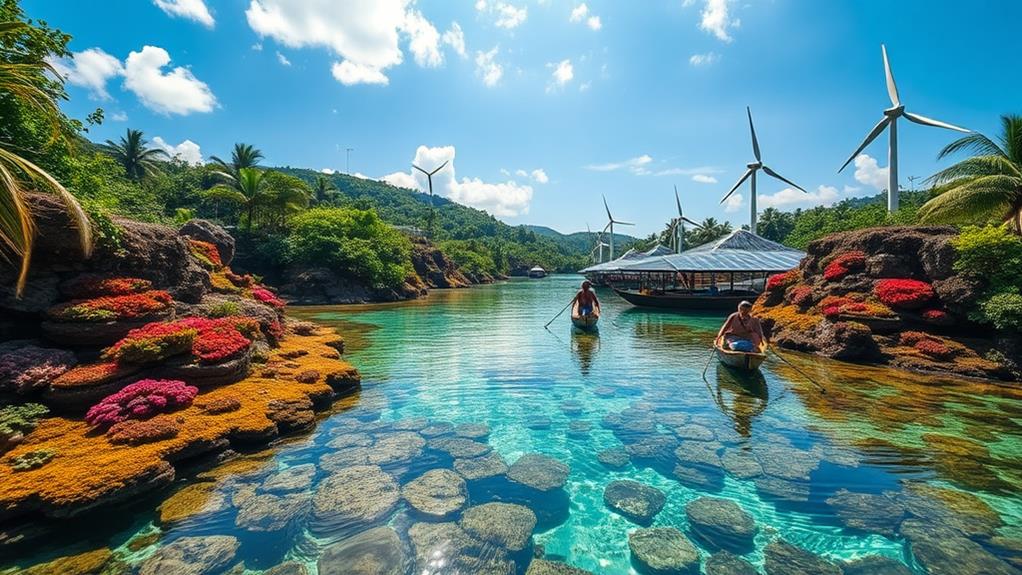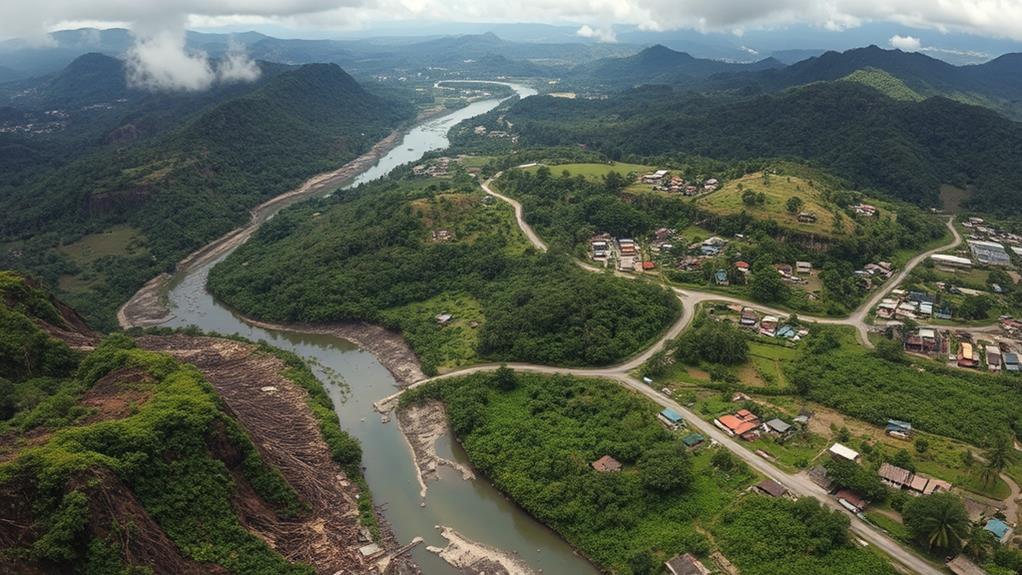Investing in sustainable natural resource industries in the Philippines is beneficial for the economy and the environment.
Government programs, such as the National Greening Program and WAVES, promote practices that protect ecosystems. By working with local communities and following regulations, investments can boost biodiversity and support climate resilience.
Sustainable forestry and mining protect resources and create jobs, helping local economies grow.
As policies continue to favor sustainability, there are many exciting investment opportunities in this field. Exploring these will uncover even more options for responsible investment.
Overview of Sustainable Investment

In the Philippines, sustainable investment is crucial for managing natural resources and improving the economy. Ecosystem services, like clean water and air, contribute billions of pesos to community well-being. The WAVES initiative helps by including forests and minerals in the country's economic accounts, which supports sustainable development goals.
Investing in forests is important for stopping deforestation. Programs such as the National Greening Program and the Forest Investment Road Map (FIRM) promote private sector participation in sustainable forestry practices. These efforts show that healthy forests are economically beneficial.
Studies funded by organizations like PROFOR demonstrate that reforestation is cost-effective and can improve water supplies while reducing flood risks.
Engaging local communities is essential for the success of sustainable investments. When residents understand the benefits of ecosystems, their involvement in data collection and policy-making becomes important.
Importance of Natural Resource Management
Effective management of natural resources is crucial for the Philippines' environment and economy. Sustainable practices help protect forests, which provide essential services worth billions of pesos and support many local jobs.
The Philippines has valuable minerals, and responsible mining can boost the economy while reducing harm to the environment.
Integrating natural resources into national economic accounts is important. For example, ecosystem accounts for areas like Laguna Lake basin and Southern Palawan can help guide better decisions. These accounts show that managing resources wisely not only protects wildlife but also makes communities stronger against climate change.
With climate change causing more extreme weather, sustainable forest management is necessary to protect vulnerable communities. Supporting programs like the National Greening Program can help stop deforestation and promote development goals.
Government Initiatives and Support

A strong set of government programs is essential for improving sustainable management of natural resources in the Philippines. The National Greening Program is designed to stop deforestation. It does this by including ecosystem services in national plans and promoting sustainable forest management. This means that forests can be used for economic needs while still protecting the environment.
The Forest Investment Road Map (FIRM) encourages businesses to invest in forest conservation. It shows the economic benefits of sustainable forest practices. This makes it more appealing for companies to invest in forest-related projects.
The WAVES initiative helps the government track the value of natural resources in economic reports. This supports sustainable development and highlights how ecosystem services are important for the economy.
The Department of Environment and Natural Resources works with other groups to create rules for responsible mineral development. This ensures that economic growth doesn't harm the environment.
The EODB Act of 2018 simplifies the process for businesses to register. This makes it easier for companies that focus on sustainable resources to operate.
These government programs work together to create a supportive environment for sustainable practices, ensuring that natural resources are wisely managed for the future.
Economic Potential of Sustainable Industries
Sustainable industries in the Philippines offer a strong economic opportunity. In 2023, the country achieved a 5.6% GDP growth, the highest in Southeast Asia. This growth shows a rising global demand for responsible resource management.
The Philippines has many mineral resources. Sustainable mining practices can help grow the economy while protecting the environment.
The National Greening Program aims to restore forests, which shows the country's commitment to managing natural resources responsibly.
Investing in sustainable forestry and reforestation can improve ecosystems and increase water supply. This leads to long-term economic benefits such as less flooding.
Recent policy changes now allow 100% foreign ownership in some sustainable sectors, making it easier to attract investment for eco-friendly projects.
Community Engagement and Participation

Many local communities in the Philippines see the important benefits of forest ecosystems, but they often struggle to engage with these resources.
Community participation is crucial for tackling problems like charcoal-making and water supply issues, which are linked to forest damage and affect people's livelihoods. By involving local stakeholders, you can help pinpoint the specific ecosystem services that communities depend on, setting the stage for sustainable practices.
Working together with researchers and community members is vital for gathering accurate data about these services. This teamwork informs policies and ensures they meet the needs of the community.
By understanding how communities use forests, you can develop strategies that improve sustainability and ensure that local people benefit from managing natural resources.
When you involve communities in governing natural resources, you promote fair and effective management practices. This approach supports the Philippines' goals for sustainable development and poverty reduction.
With active community participation, you can help create a more resilient and sustainable future for the Philippines' natural resources.
Funding Opportunities and Grants
Securing funding for sustainable natural resource initiatives in the Philippines offers great opportunities for community projects. There are two main types of grants available: partnership/project development grants and strategic large grants. You can apply for partnership grants of up to £50,000. These grants aim to encourage teamwork among different fields, leading to new ways to improve mineral production and care for the environment. They help protect ecosystems and support forest investments for better resource management.
After receiving a partnership grant, you may be eligible for strategic large grants of up to £1.2 million. This funding is only available to those who've proven their worth through previous projects. The Department of Science and Technology – Philippine Council for Industry, Energy and Emerging Technology Research and Development (DOST-PCIEERD) provides funding to qualified researchers, enhancing the research environment in the Philippines.
Furthermore, the three-year Knowledge Exchange Fellowship encourages cooperation and sharing of information among all involved parties. This helps improve the success of sustainable resource management efforts.
Role of WAVES in the Philippines

The Philippines needs to recognize the value of its natural resources for sustainable development. WAVES-Philippines helps achieve this by including natural resources in national economic accounts. This is important for smart development planning and growth.
WAVES has created asset accounts for minerals like gold, copper, nickel, and chromium from 2000 to 2012. This information helps the government make informed decisions.
Ecosystem accounts for areas like the Laguna Lake basin and Southern Palawan allow for better-targeted policies, which support the sustainable management of these critical resources.
WAVES is led by the National Economic and Development Authority (NEDA) and includes many government agencies. This teamwork helps manage natural resources and addresses competing claims on them.
Global Partnerships and Collaborations
Global partnerships and collaborations are essential for improving sustainable development in the Philippines. These partnerships help in natural capital accounting and the Valuation of Ecosystem Services. This means they make it easier for decision-makers to understand the value of nature in the economy.
The WAVES initiative helps countries include natural resources in their economic accounts. The Global Program on Sustainability (GPS) supports better decision-making in developing nations. The WAVES Knowledge Center offers free resources to share information among different groups.
Regional Learning Platforms use lessons from the Africa Natural Capital Accounting Community. By joining these efforts, the Philippines is committed to natural capital alongside eight other countries.
These global partnerships provide access to best practices and new strategies for managing resources. They strengthen the Philippine Development Plan and ensure that natural resources are considered in economic planning.
Engaging in these partnerships is an investment in a sustainable future for the Philippines, highlighting the importance of working together to achieve long-term environmental and economic goals.
How Can Technology Enhance Sustainability in Natural Resource Industries in the Philippines?
Technology in sustainable resource management can greatly enhance the natural resource industries in the Philippines. Utilizing advanced technological solutions can help in monitoring and minimizing environmental impacts, optimizing resource extraction processes, and promoting eco-friendly practices. This can lead to improved resource sustainability, decreased ecological footprint, and overall better management of the country’s natural resources.
Challenges in Sustainable Resource Development

The main obstacles hindering sustainable resource development in the Philippines include government actions, inefficiencies, and market conditions. A significant issue was the government-imposed moratorium on mining from 2016 to 2018, which aimed to protect the environment but halted many projects. This moratorium has affected ongoing efforts to develop resources sustainably.
Bureaucratic inefficiencies and corruption are also major challenges. These issues create barriers for companies trying to follow environmental regulations and develop minerals responsibly. For example, delays in permits and approvals can stop projects from moving forward.
Another problem is poor infrastructure and high logistics costs. These factors make it hard for companies involved in sustainable resource industries to operate efficiently. When costs are high, potential investors may choose not to invest.
Moreover, the dominance of large family-owned conglomerates limits competition. This situation makes it difficult for smaller businesses to innovate and implement responsible practices, as they may lack the resources or market access.
Lastly, regulatory complexities create uncertainty for investors. A complicated legal framework and inconsistent investment incentives can confuse potential backers. For instance, different regions may have varying rules, making it hard to know what to expect.
To improve sustainable resource development, it's essential to advocate for clearer regulations, better infrastructure, and support for small enterprises. By addressing these issues, the Philippines can protect its environment while creating a better climate for sustainable investment.
Future Prospects for Sustainability
Fostering a culture of sustainability in the Philippines can greatly benefit the economy and the environment. Sustainable practices help manage natural resources responsibly, which leads to both ecological balance and economic growth.
Forest investments can yield high returns by improving ecosystem services like clean air and water. For example, planting trees can help prevent soil erosion and support wildlife. The National Greening Program aims to reverse deforestation and promote biodiversity by planting millions of trees across the country. This program helps restore habitats and supports local wildlife.
Sustainable mining practices can reduce environmental damage while benefiting local communities. For instance, using less harmful techniques can decrease pollution and create local jobs. Collaboration among stakeholders ensures that communities receive benefits from sustainable resource management, such as better infrastructure and education.
Data-driven decision-making makes forestry and reforestation more attractive for investment. Accurate data helps investors see the potential benefits of supporting sustainable projects. The Philippines has begun integrating natural resource accounting into its economic plans, showing a commitment to responsible management.
The National Greening Program provides a path toward climate adaptation and poverty reduction. By restoring forests, the program helps communities become more resilient to climate change. Additionally, the creation of a national database on forest ecosystem services supports informed decision-making, which attracts more investments and promotes sustainable jobs.
Questions and Answers
What Is the Most Invested Field in the Philippines?
The most invested field in the Philippines is the manufacturing sector. This sector includes industries like electronics, food processing, and textiles. These industries are crucial for the country's economy as they create jobs and support local communities.
Another growing area is renewable energy. This includes solar, wind, and hydropower projects. The government is promoting these initiatives to help combat climate change and reduce reliance on fossil fuels.
Eco-tourism is also gaining attention. This focuses on attracting tourists to natural attractions while promoting conservation. Examples include visits to the Banaue Rice Terraces and Palawan's beautiful landscapes.
What Are the Top 5 Natural Resources in the Philippines?
The top five natural resources in the Philippines are nickel, copper, gold, forests, and marine resources.
Nickel is important for making stainless steel and batteries. The Philippines is one of the world's largest producers of nickel ore.
Copper is used in electrical wiring and plumbing. The country has large copper deposits, making it a key player in the global copper market.
Gold is valuable for jewelry and as an investment. The Philippines has rich gold mines, and it is known for high-quality gold production.
Forests cover about 23 million hectares of the country. They are crucial for wildlife habitats, carbon storage, and providing timber.
Marine resources include fish and other ocean life. The Philippines has one of the richest marine biodiversity areas in the world, supporting local economies and food supply.
Effective management of these resources ensures they will be available for future generations.
What Is the Demand for Sustainable Products in the Philippines?
The demand for eco-friendly products in the Philippines is increasing. 67% of consumers prefer sustainable brands. This shows that more people are choosing to buy products that are better for the environment. For example, many shoppers are looking for items like reusable bags, organic food, and products made from recycled materials. This change reflects a growing interest in responsible consumption and healthier choices.
What Is the Most Sustainable Place in the Philippines?
Palawan is the most sustainable place in the Philippines. It is known for its eco-friendly projects and dedication to sustainable tourism. For example, Palawan has programs that protect its natural resources and wildlife. The local government promotes responsible travel practices that help preserve the environment. These efforts serve as a good example of how to maintain nature while also supporting local economies.